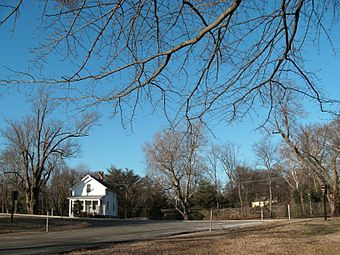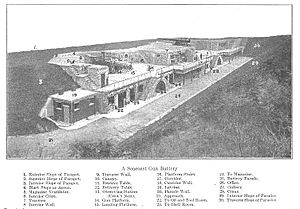Fort Hunt Park facts for kids
|
Fort Hunt
|
|

Entrance to the park
|
|
| Location | Mount Vernon Memorial Hwy., Alexandria, Virginia |
|---|---|
| Area | 136 acres (55 ha) |
| Built | 1897 |
| Built by | U.S. Army |
| Architectural style | Endicott system |
| Website | Fort Hunt Park |
| NRHP reference No. | 80000353 |
Quick facts for kids Significant dates |
|
| Added to NRHP | March 26, 1980 |
Fort Hunt Park is a public park in Fort Hunt, Fairfax County, Virginia. The National Park Service manages it as part of the George Washington Memorial Parkway.
This park protects what is left of Fort Hunt. Parts of the fort date back to the Spanish–American War (1898). The park got its name from Brigadier General Henry Hunt. He was a top artillery officer during the Civil War.
You can still visit parts of the fort's old gun stations, called batteries. These include Battery Mount Vernon, Battery Robinson, Battery Sater, and Battery Porter. Battery Porter was named after Lt. James Ezekiel Porter, an officer who died at the Battle of the Little Bighorn. These structures are safe to explore today.
The fort's old commander's station is also still standing. A flagpole has been put up to remember the intelligence officers who worked at the fort during World War II. Fort Hunt Park is open from sunrise to sunset all year. You can get there from the George Washington Memorial Parkway or Fort Hunt Road.
Park History
Fort Hunt is located along the Potomac River. It is only about 11 miles south of Washington, D.C.. Being so close to the nation's capital greatly shaped its history. What happened here often reflected major events in U.S. history.
The land was once part of George Washington's River Farm. It stopped being owned by Washington's family in the early 1800s. It then remained farmland until after the American Civil War.
Building the Fort
A fort was built here as part of a plan from the 1880s. This plan aimed to make the defenses around Washington, D.C., stronger. Fort Hunt was designed to work with Fort Washington. Fort Washington is just across the Potomac River in Maryland.
Fort Hunt was finished in time for the Spanish–American War. However, it did not see any fighting in that war. The park was named after Brig. Gen. Henry Hunt, a Civil War artillery leader.
Fort Hunt in the 20th Century
On June 11, 1932, General Douglas MacArthur set up a hospital at Fort Hunt. This hospital helped military veterans known as Bonus Marchers. They were camped in Washington, D.C.
In the 1930s, the site became a Civilian Conservation Corps camp. This program helped young men find work during the Great Depression.
During World War II, Fort Hunt was used for top-secret military operations. These were known as "P. O. Box 1142". It was also a place where important prisoners of war were questioned. At one time, the United States Army had a finance school here, but it did not last long.
Fort Hunt Today
Today, Fort Hunt Park is a popular place for picnics and jogging. It also has a playground and sports fields. The United States Park Police have a station and stables for their police horses at the park.
In June 1944, a German officer named Lieutenant Commander Werner Henke died at Fort Hunt. He was trying to escape from the fort. In 1980, the remaining buildings at the site were added to the National Register of Historic Places. This means they are important historical places.
The nearby community of Fort Hunt, Virginia is named after the original fort.
Gallery









